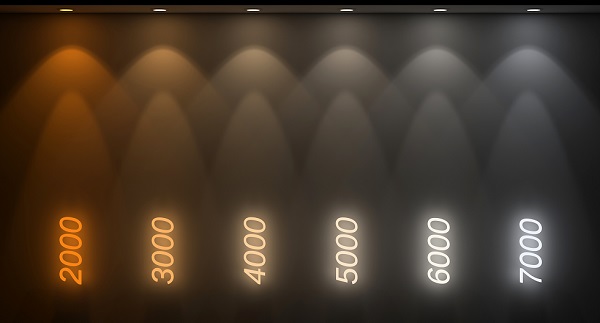Here are six essential specifications you should focus on when designing LED and LED lighting systems for home, commercial, and industrial applications.
LEDs are not just for indication anymore – powerful lighting LEDs or chip on board (COB) LEDs can produce thousands of lumens, and even low-power LEDs are becoming more specialized. These six design considerations can focus your approach.
1.) LED Color Temperature
While you probably know how bright you want your LED to be (at least when it comes to the choice between using a blinker on a circuit or a light source), color temperature and lumens per Watt may be a lot less obvious. Color temperature only applies to white light: it’s the measure of how cool (bluish) or warm (reddish) the light appears. This can be deceptive because the color of light, measured in Kelvins (K), officially describes the appearance of a metal (black body radiator) burning at various high temperatures. Therefore, the “cooler” or bluer colors are actually higher in temperature. Warm light is generally considered 2700K to 3500K, neutral white is about 4000K, and cool white is anything above 4700K.
The light temperature you choose is dependent upon the type of consumer or industrial application you’re building. For example, warmer colors tend to make people look better and food more appetizing. Warm (reddish) light is even used in grocery stores to make the meat and produce look more appealing. Cool whites are the common choice for office environments because they mimic daylight and increase serotonin production, keeping people more focused, alert, and energized. Because cool white lights are easier to achieve with the current LED die and phosphors available, LEDs at high color temperatures tend to be cheaper and more efficient. This chart shows the temperature difference between warm (fire-like) light versus the cooler (daylight) white light.

Figure 1: Visualization of Kelvin color temperatures.
2.) LED Light Wavelength
Another common issue people have when selecting LEDs is that the shade of green or blue is not what they expected. To get the color you really want, you must pay attention to the wavelength spec to determine if you’re going to get a true green versus a yellow-green, for example. To learn more about LED wavelengths and to see a visual representation of each LED wavelength in action, check our video: LED Colors by Wavelength
3.) LED Efficiency – Lumens per Watt
Efficiency is measured in lumens per Watt (lm/W), which is the total lumens emitted by the LED divided by the total power consumed. As a rule of thumb, customers tend to aim for 100 lm/W from an entire system. This includes any losses due to heat, lensing, light guides, and power conversion, so often an LED with 140 lm/W or higher is necessary. Big names in LED lighting like CREE and Samsung offer LEDs with up to 200 lm/W, and note exactly where it is possible to achieve that rating. The maximum efficiency of an LED is often achieved at a current much lower than the maximum rating, so lighting is far from exempt from the cost-vs-efficiency discussion.
4.) LED Indicator Lights
If your application requires simple visual notification—the blinking lights on a router, for instance—you can simplify the entire process and go with an indication LED. Indication LEDs are available in just about any color and can be as large or as small as the application requires. Arrow carries LEDs in 0402 packages up through 10 mm T-3 packages. Buying pre-packaged bar lights and groups of LEDS can save you time in your next design.
5.) LED Wavelength Visibility
Visibility depends on the viewing angle of the LED and how well our eyes see the selected color, as well as the lumen output of the diode. For example, a green LED run at 2 mW may look as bright to us as a red LED run at 20 mA. Human eyes see green better than any other wavelength, and the sensitivity trails off toward infrared and ultraviolet on either side of that peak. Check out the visible light spectrum below for reference. Red is one of the more difficult colors to make bright to the human eye because it’s closer to the edge that shifts into non-visible infrared light. Ironically, red is the most common color used as an indicator.

Figure 2: Visible spectrum colors of light by wavelength.
6.) LED Viewing Angle Explained
The viewing angle of an LED refers to the distance from the center of the beam before the light has lost half its intensity. Common values are 45 degrees and 120 degrees, but a light pipe or other light guide, which focus the light into a beam, will likely require a tighter viewing angle of 15 degrees or less.
Keep these six considerations in mind and your next LED design will be optimized for impact. Want to know if you’re better off with an OLED display? We break it down in LEDs vs. OLEDs: Which Display is Best? If you are designing a full lighting solution, check out our lighting designer tool, a cloud-based platform created to aid in designing a complete LED lighting system solution.



